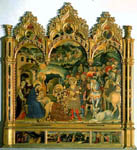Gentile da Fabriano was born in Fabriano in about 1370. He was a representative of the international gothic movement and was also fully acquainted with Flemish culture and culture in Lombardy. His early works, such as the Polyptich of Valle Romita,  show the features typical of his painting style: rich drapings, sumptuous clothes, linear outlines (typical of the international gothic movement). There is evidence to show that in 1408 the painter was in Venice and painted a fresco in the palazzo ducale (it has not survived). From 1414 to 1419 he was in Brescia, then he probably moved to Fabriano and Siena; in Florence, in 1422, he painted the famous Adoration of the Magi in the chapel of Palla Strozzi in Santa Trinità (the painting is now in the Uffizi Gallery, in Florence). This painting has survived intact in its carved frame, painted golden. The figures in the painting are in an almost story-like atmosphere but great attention has been given to details like flowers and plants. In 1425, in Florence, he painted the Quaratesi Polyptich, currently divided into four parts and kept in London, Florence, the Vatican and Washington; in that same year the artist was in Siena and Orvieto, where he painted some frescos in the duomo. In 1427 he was in Rome, where he started painting some frescos in the basilica of St John in the Lateran. The frescos were destroyed in the XVII century when the church was renovated.
show the features typical of his painting style: rich drapings, sumptuous clothes, linear outlines (typical of the international gothic movement). There is evidence to show that in 1408 the painter was in Venice and painted a fresco in the palazzo ducale (it has not survived). From 1414 to 1419 he was in Brescia, then he probably moved to Fabriano and Siena; in Florence, in 1422, he painted the famous Adoration of the Magi in the chapel of Palla Strozzi in Santa Trinità (the painting is now in the Uffizi Gallery, in Florence). This painting has survived intact in its carved frame, painted golden. The figures in the painting are in an almost story-like atmosphere but great attention has been given to details like flowers and plants. In 1425, in Florence, he painted the Quaratesi Polyptich, currently divided into four parts and kept in London, Florence, the Vatican and Washington; in that same year the artist was in Siena and Orvieto, where he painted some frescos in the duomo. In 1427 he was in Rome, where he started painting some frescos in the basilica of St John in the Lateran. The frescos were destroyed in the XVII century when the church was renovated.
Gentile da Fabriano died in Rome in 1427.